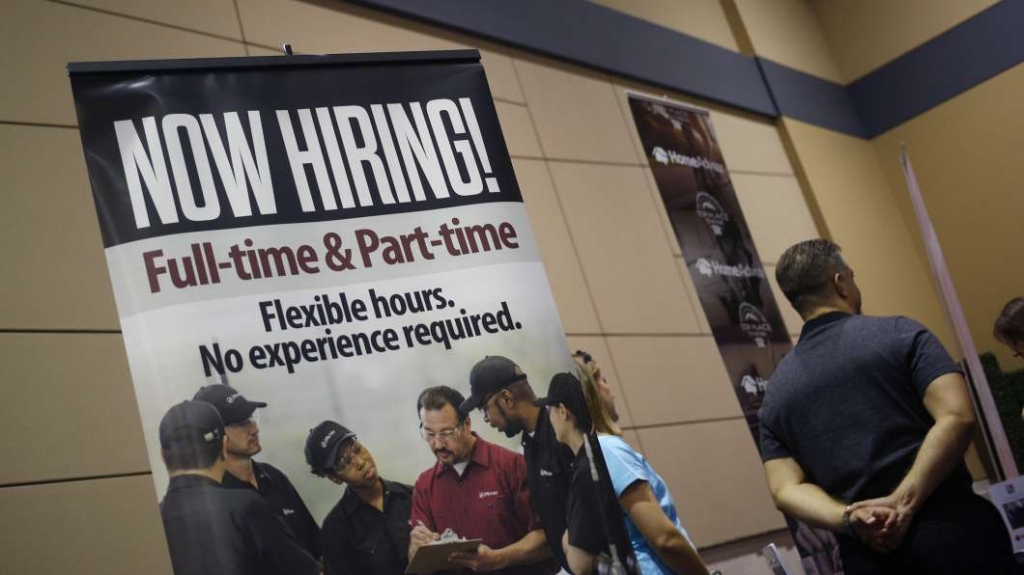-
Tips for becoming a good boxer - November 6, 2020
-
7 expert tips for making your hens night a memorable one - November 6, 2020
-
5 reasons to host your Christmas party on a cruise boat - November 6, 2020
-
What to do when you’re charged with a crime - November 6, 2020
-
Should you get one or multiple dogs? Here’s all you need to know - November 3, 2020
-
A Guide: How to Build Your Very Own Magic Mirror - February 14, 2019
-
Our Top Inspirational Baseball Stars - November 24, 2018
-
Five Tech Tools That Will Help You Turn Your Blog into a Business - November 24, 2018
-
How to Indulge on Vacation without Expanding Your Waist - November 9, 2018
-
5 Strategies for Businesses to Appeal to Today’s Increasingly Mobile-Crazed Customers - November 9, 2018
U.S. employers Add Only 138K Jobs, Unemployment Rate Dips
The data suggest employers are starting to add to payrolls more slowly in a tight labor market.
Advertisement
The U.S. added only 138,000 jobs in May, but hiring was enough to push unemployent lower. With the recovery from the Great Recession having reached its eighth year, hiring is gradually weakening.
“Some of this is due to businesses finding it more hard to locate workers with the right skills as the labor market gets tighter”, Faucher and Hoffman said. “The pool has diminished considerably”. March jobs fell to 50,000 from 79,000 while April’s total dropped to 174,000 from 211,000 jobs. Over the last 12 months, this sector has added 267,000 jobs, so this month’s figures actually beat the average over that period. Through May, employers added an average 162,000 jobs to payrolls each month, a slower pace than the 187,000 jobs added monthly, on average, in 2016.
But Mark Hamrick, Bankrate.com’s senior economic analyst, said that Trump “vastly overstated jobs creation since he took office and the assessment has only worsened with the arrival of a new day and the latest employment report”.
Economists, in fact, said it was unlikely that even sluggish hiring in May would keep the Fed from raising its key short-term interest rate by a quarter percentage point at a mid-June meeting. Employers have added jobs every month since October 2010. Still, the rate declined mainly for a less-than-encouraging reason: People stopped looking for work in May and so were no longer counted as unemployed. Some economists pointed out that the retirement of baby boomers would continue to press down labor-force participation. In addition, companies are increasingly seeking workers with college degrees or specialized know-how – construction experience, for example, or a background in machine automation.
The decline in that measure is an encouraging sign that jobless people who had given up hope of working are now being hired. So far, that hasn’t happened broadly across the economy.
In May, average hourly earnings for all employees on private nonfarm payrolls rose by 4 cents to $26.22. Restaurants and health care companies posted solid gains.
Last month, hiring was improved in the construction sector and was relatively strong in health care.
Government employment decreased 9,000 last month, with state and local governments accounting for all the decrease. And manufacturers let go of 1,000. Retailers trimmed their ranks by 6,100 jobs. The number of long-term unemployed (those jobless for 27 weeks or more) was essentially unchanged over the month at 1.7 million and accounted for 24.0 percent of the unemployed.
This year’s job gains will nearly certainly go up Friday, though a litany of factors, not just the White House, influence employers’ hiring decisions. And its proposed tax cuts have come only in a one-page outline, without the details that would need to be vetted by Congress.
The unemployment rate, which is calculated from a different survey, fell from 4.4% to 4.3%, lowest since May 2003, the Labor Department said Friday. But with the labor market expected to hit full employment this year, there is optimism that wage growth will accelerate. This unseen supply was keeping wages lower.
“I don’t think today’s report will change many minds at the Fed”, says Andrew Chamberlain, chief economist at Glassdoor.
Advertisement
Federal Reserve Bank of Philadelphia President Patrick Harker said Friday he expects the unemployment rate to fall further and forecasts that to translate into better wages, up to a 3 percent increase this year.




























